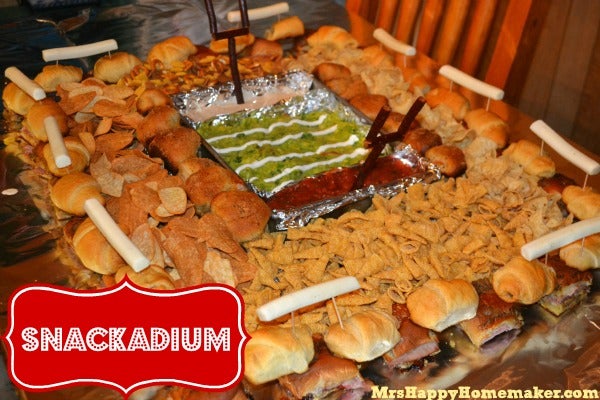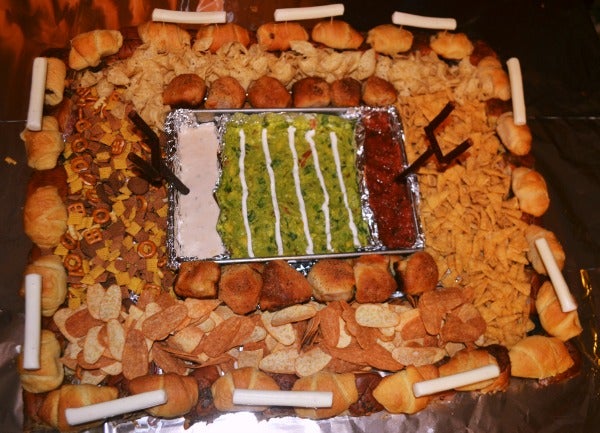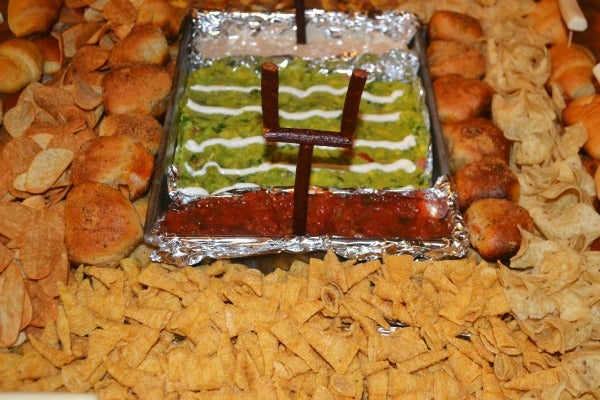It’s shaped like a miniature football stadium, yet, in place of the field, you’ll find a pan of guacamole. In place of the players, there are meatballs or pepperoni. In the stands, you won’t find screaming fans, but popcorn, tortilla chips, Chex Mix and other snacks. And on the exterior, rows and rows of delicious sandwiches surround the tiny stadium, providing a backbone to its delicate architecture with sumptuous slices of cheeses and meats.

This, ladies and gentlemen, is what’s known as a “snackadium,” “snack stadium” or “meat stadium.” (One particularly impressive example was even dubbed “The Meatrodome.”) If you’re unfamiliar with the concept, it’s simple: A curated arrangement of foods — primarily meats, sandwiches and snacks — designed to look like a miniature, edible football stadium.

Snackadiums are usually built around Super Bowl season — and many have gone viral around that time — but I see no reason why such beautiful structures should be constrained to the early part of the year. So, with the help of a couple gurus who’ve built some of the best-looking snackadiums on the internet, I decided to build my own meat stadium. But as I’d soon find out, making one wasn’t exactly the slam dunk I thought it would be.
Step #1: Figure Out How Much Food You Need
Snackadiums are a work of art, but for the uninitiated, it can be tough to figure out how many people one will feed. Take this one, for instance: Can it feed 20 people? Fifty people? I have no idea.

This particular snackadium was built by Crystal Light, the founder of the food blog Mrs. Happy Homemaker (she’s also a food contributor on Fox News). Back in 2014, she was asked to construct a snackadium by Pillsbury, and she’s made a couple of them since. When trying to determine how much food you’ll need, she recommends starting with the bigger items, then figuring how many people they’d serve. For hers, the big items were ham and swiss sliders, pigs in a blanket and balls of dough stuffed with pepperoni. So, she estimated how many of those would be eaten, and went from there. For the chips and other snacks, she didn’t bother measuring serving sizes because they’re tough to gauge. Instead, she just got enough to fill the space she’d allotted for them.
For me, it was tough to figure out because I wasn’t throwing a party, per se — I just wanted to make one of these suckers for the hell of it. It’s only myself, my wife and my daughter at home, so I gave myself the vague goal of just not wasting too much food, but still having an impressively sized structure.
Step #2: Make a Plan
Light advised me that a plan for a snackadium didn’t need to be too complicated. She drew hers up on notebook paper, with broad ideas of which foods would go in each spot.

During the planning phase, you mostly need to decide what your basic stadium concept will be. For Light, her snackadium was pretty much all food sitting on a table, with only the central dish in the middle for her guacamole field. On the other hand, interior designer and TV host Tracy Metro — who built her “Meatrodome” for the Hallmark Channel in 2013 — built a huge cardboard substructure.
With this in mind, I got a piece of printer paper and some colored pencils and came up with this blueprint:
I had to base a lot of my plan around the space the stadium would sit on. My dinner table is round and just four feet in diameter, so my stadium had to be smaller than that. I also knew that I wanted to have sandwiches around the edges; thus, most of my proportions were going to be based around how many feet of sandwiches I needed, which ended up being 10 feet. Not being quite as crafty as Metro, I decided that I was going to have mine sit on a basic cardboard framework, but nothing too complicated.
Step #3: Determine Your Ingredients
Putting together a snackadium can be kind of overwhelming, but Light advises that you “look at each individual thing and think of food elements that would match that look.” Guacamole can look like the football field if it’s flatted out in a pan, and piles of snacks can pass for crowds of people. For Light, one of the most fun details was figuring out what could represent the players. “I was trying to figure out what food might look like helmets, and that’s how I came up with the pepperoni balls that are on the sidelines. Since that first one, I’ve also used meatballs to represent the players,” she says.

I liked the idea of having the players represented in some cool way, and for a moment, I considered using dinosaur chicken nuggets as the teams. But I reconsidered after I remembered that nuggets don’t taste good cold and might be gross sitting in guacamole, which I planned to use for my football field. Instead, I chose pigs in a blanket, with one team being plain-flavored and the other being covered in everything seasoning. Not to toot my own horn, but I think that’s pretty damn clever.
Step #4: Buy Your Supplies
Per Light, how much your snackadium is going to cost will depend on the amount and quality of ingredients that you buy. “I’ve made a large snackadium for about $75, and I’ve also made little ones for just me and my three kids that cost me only about $30,” she tells me.
Somehow, to get everything I needed for mine, I ended up spending $200 at Walmart. I may have overestimated how many of some ingredients I needed.
Step #5: Construct Your Base
When putting together her base, Light first wrapped her entire table in aluminum foil, whereas Metro built her cardboard substructure. As for me, I layed out a huge cardboard presentation board and started repositioning the bread until I got to a stadium size I liked. I then cut the cardboard down where I needed to.
Light had told me to make sure the edges of my stadium had a “good height to them,” so I decided to stack my sandwiches on top of soda cans to give it that sloped feel. Once I figured out where the bread was going around the cardboard, I put a layer of soda cans underneath to give the stadium some height and structure.
Step #6: Apply the Food
Light advised me to build my stadium from the center outwards, starting with the football field itself. And so, I took a square baking pan, glued it into a rectangle baking pan and put it into the center of my cardboard. Then I put guacamole in the center, ranch dip in one end zone and salsa in the other to represent different team colors.
Next, I cut a bunch of cardboard for the dividers and taped them to the inside. For ingredients like popcorn and Tostitos, I just poured them right in. I was short on a few ingredients, like grapes and tomatoes, so for those, I folded up some cardboard underneath to prop them up a bit. After that, I cooked up some pigs in a blanket, made a bunch of sandwiches and went with Light’s clever idea of Slim Jims for goalposts. Behold:
Honestly, I’m pretty damn proud of this thing. It took me about five hours to put it all together. Sadly, by the time I was done, I was too full to eat any of it because I was snacking the entire time, but I still felt great about how it came together. My favorite detail was my little football players. I mean, just look how goddamn cute this is!
Step #7: Eat!
Generally, these kinds of things are made for parties, but I made this on a random Thursday. I waited until my wife and kid got home to see what they thought before indulging in (much) of it myself.
Needless to say, both of them were impressed. “Baby, it’s beautiful,” my wife said (though she was probably just happy that she didn’t come home to find me deep-frying a T-shirt). As for my daughter, who is seven, she said it was “so cool” before digging into the strawberries and referring to it as a “basketball game.”
In terms of cleanup, which, admittedly, was extensive, I put as much of the food as I could in the freezer, the rest went into the fridge, and I chucked out the cardboard, which was now covered in crumbs, guacamole and cheese ball grease. I guess it was pretty silly to make a snackadium without a party, but it was still pretty fun. Plus, now I have a new skill for whenever I’m invited somewhere to watch the Super Bowl — I’ll just have to make sure my daughter knows what sport that is first.

